Sky notes for 2025 April & May
2025 April 1

One hundred years ago, a paper was presented at a joint meeting of the American Astronomical Society and American Association for the Advancement of Science in Washington, D.C. by Henry Norris Russell on behalf of Edwin Powell Hubble. The date was Jan 1, and in the paper, Hubble announced his discovery of 12 Cepheid variables in the Andromeda Nebula (Messier 31, or M31) and 22 in M33 in Triangulum, demonstrating that these ‘nebulae’ were outside the Milky Way. We now take for granted the fact, showed by Hubble’s observations of these Local Group objects, that our Universe is made of billions of galaxies, as we now call them.
The deep sky
While M31 and M33 are best viewed in autumn, the spring sky is blessed with superb examples that lie a little beyond the Local Group but still show rich detail for the amateur community. Their proximity to the galactic pole avoids the Milky Way Galaxy’s gas and dust clouds, thus reducing obscuration. April in particular is a wonderful month to enjoy the star cities that populate the outskirts of the crowded Virgo Cluster of galaxies, that stretches from Ursa Major down to Corvus in the south, and Leo in the west to Boötes in the east – the ‘Realm of the Galaxies.’ It is worth spending many nights observing some of the most spectacular objects in the centre of this richness.
It is easiest to begin at Ursa Major, as the Great Bear prowls high in the late-spring sky. At its eastern end, the exaggerated tail of which no true ursine can boast, we find two magnificent spirals. M101 (Figure 1) is superb: a face-on, loosely wound SAB-type galaxy, around 21 million light-years distant. From Alkaid, sweep 5 degrees northeast, and the nucleus will come into view, although the low-surface-brightness spiral arms will not. At magnitude 7.7, it can be observed using binoculars, but due to its small size, large apertures are required to tease out the arms. However, imaging captures the delicate, knotted star-forming regions exquisitely. It is a large galaxy, some 184,000 light-years across, spanning 28 × 27 arcmin – almost equivalent to the full Moon in extent.

While Ursa Major is full of fascinating galaxies to explore, we move southwards to more marvels, beginning with one of the most imaged galaxies in the heavens: the wonderful Whirlpool, M51. Although nearer to Alkaid than M101, it lies in Canes Venatici, the Hunting Dogs, just 3 degrees to its southwest. Another popular galaxy is at a similar declination to M51, but a little further west. This is M106 (Figure 2, previous page), an 8th-magnitude SAB spiral that spans 18 × 7 arcmin. The bright nucleus is easy enough, while the tilted spiral arms resemble those of M31 in many ways. It is around 24 million light-years from us.
The stars of Canes Venatici are not prominent other than alpha (Cor Caroli) and beta (Chara) which nestle in an otherwise rather sparse area under the tail of Ursa Major. Cor Caroli is an easy double star for small telescopes, its components of magnitude 2.9 and 5.6 separated by 19.6 arcsec. Any colour is in the eye of the individual! Between these stars lies M94 (the ‘Crocodile’s Eye’; Figure 3) which forms a flat triangle with them. M94 is a difficult galaxy in which to discern structure, as it is a very tight spiral. At magnitude 8.2, it is not difficult to find, but examining the faint rings requires deep imaging. It is intrinsically smaller than M101 and M106, being 56,000 light-years across, and although 17 million light-years distant, it subtends a disc of 11 × 9 arcmin.
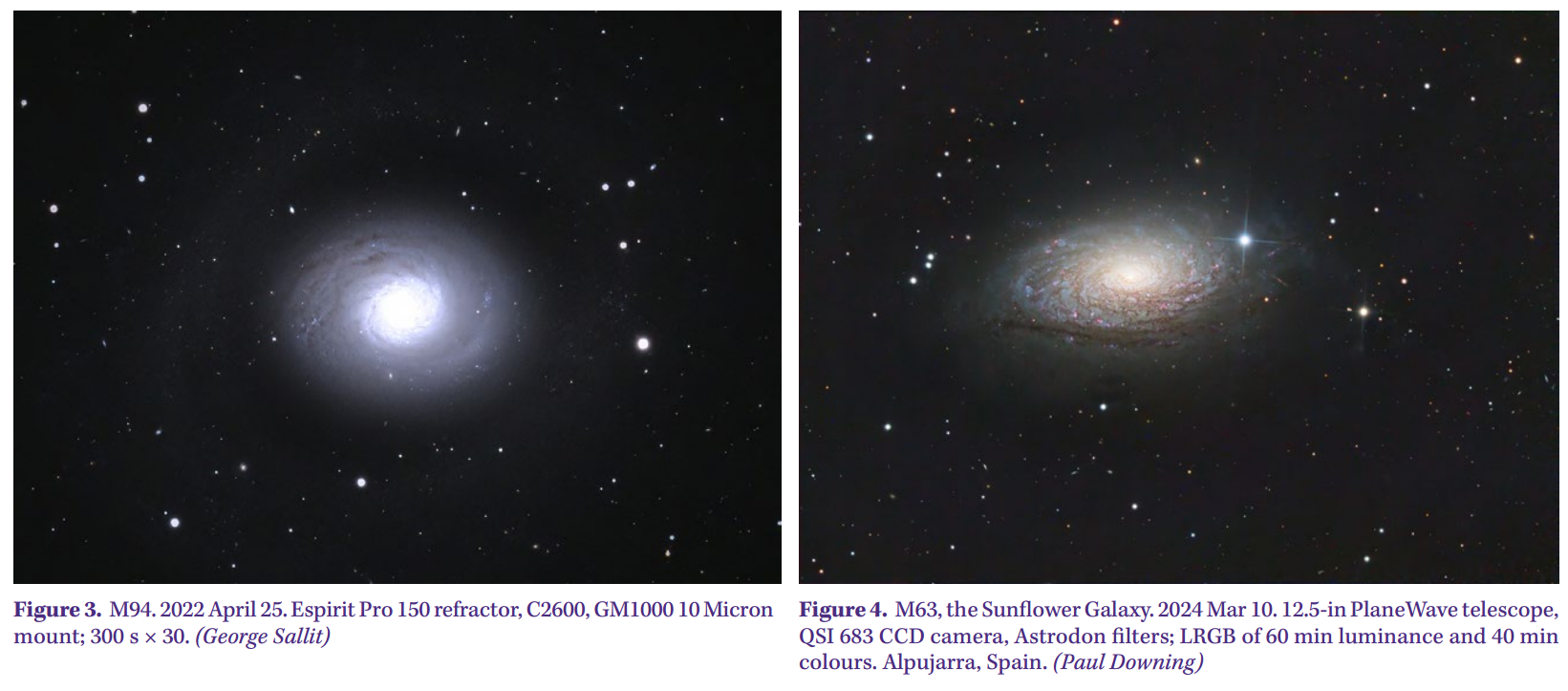
Sweep due east from Chara to a quite different-looking galaxy: M63, the ‘Sunflower’ (Figure 4). This galaxy has a very knotted appearance, described as ‘flocculated’, with clumps of material scattered throughout the numerous spiral arms, which are seen obliquely. Its multiple arms are said to resemble those of our own Milky Way, and its size is only slightly smaller, at an estimated 98,000 light-years. It has an almost stellar nucleus, measuring 6 arcsec, with the rest of the galaxy extending to 12.5 × 7 arcmin. This very beautiful spiral lies 30 million light-years away, halfway to the huge Virgo Cluster.

While in the vicinity of these star cities, track down ‘La Superba’, the very red carbon star Y Canes Venatici (Figure 5). It is a good binocular star to follow, as it is a semiregular variable that ranges from magnitude 5.2 to 6.6 over a period of approximately 160 days. See a recent note in the Journal for details on the origin of the nickname.1
Returning to the cornucopia of galaxies in Canes Venatici, do not miss out on the many NGC specimens on show, including NGCs 4490 and 4485 just west of Chara, the irregular galaxy NGC 4449 a couple of degrees to the north, and NGC 4631 (the ‘Whale’; Figure 6) in the same low-power field as NGC 4656 (the ‘Hockey Stick’).

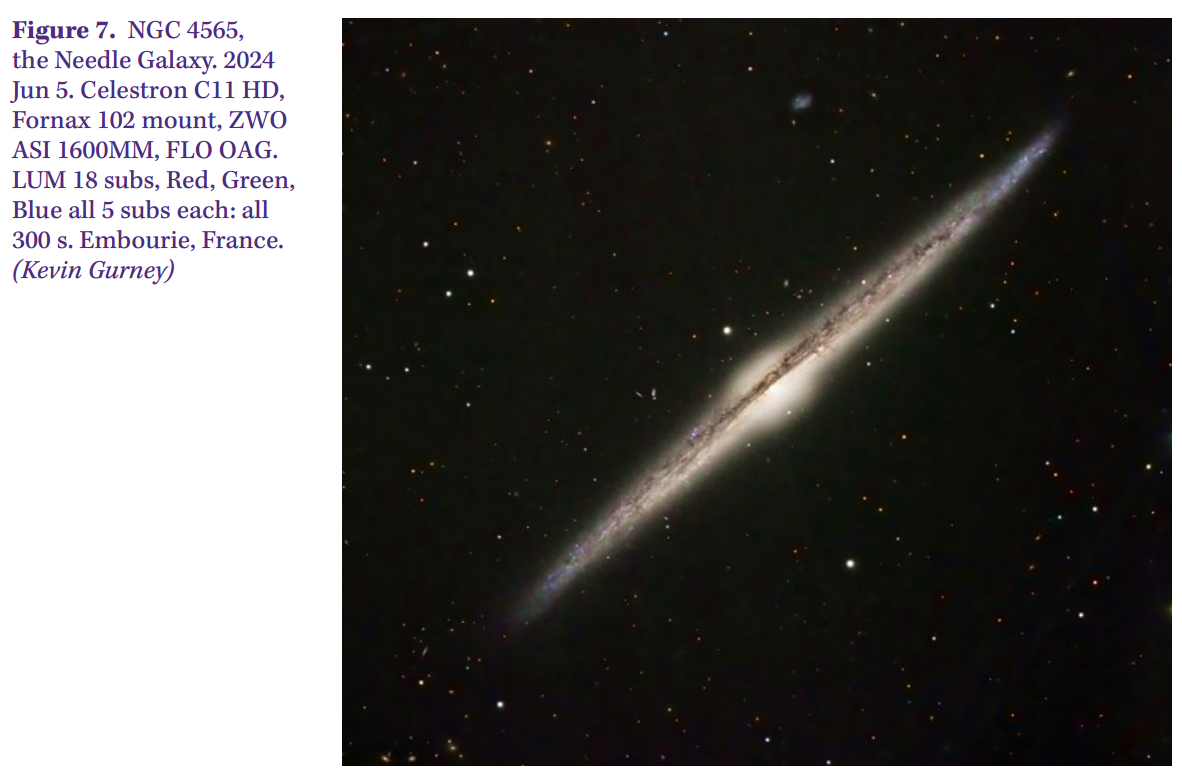
Going further south, we slip into Coma Berenices and encounter one of the best edge-on galaxies, NGC 4565 (the ‘Needle’; Figure 7), which lies to the east of the Coma Star Cluster, a loose but prominent open cluster just south of gamma Comae. The Needle’s dark lane is visible in small telescopes, and great detail is possible with larger apertures. It spans 16 arcmin and is magnitude 10.5 at a distance of 40.2 million light-years.
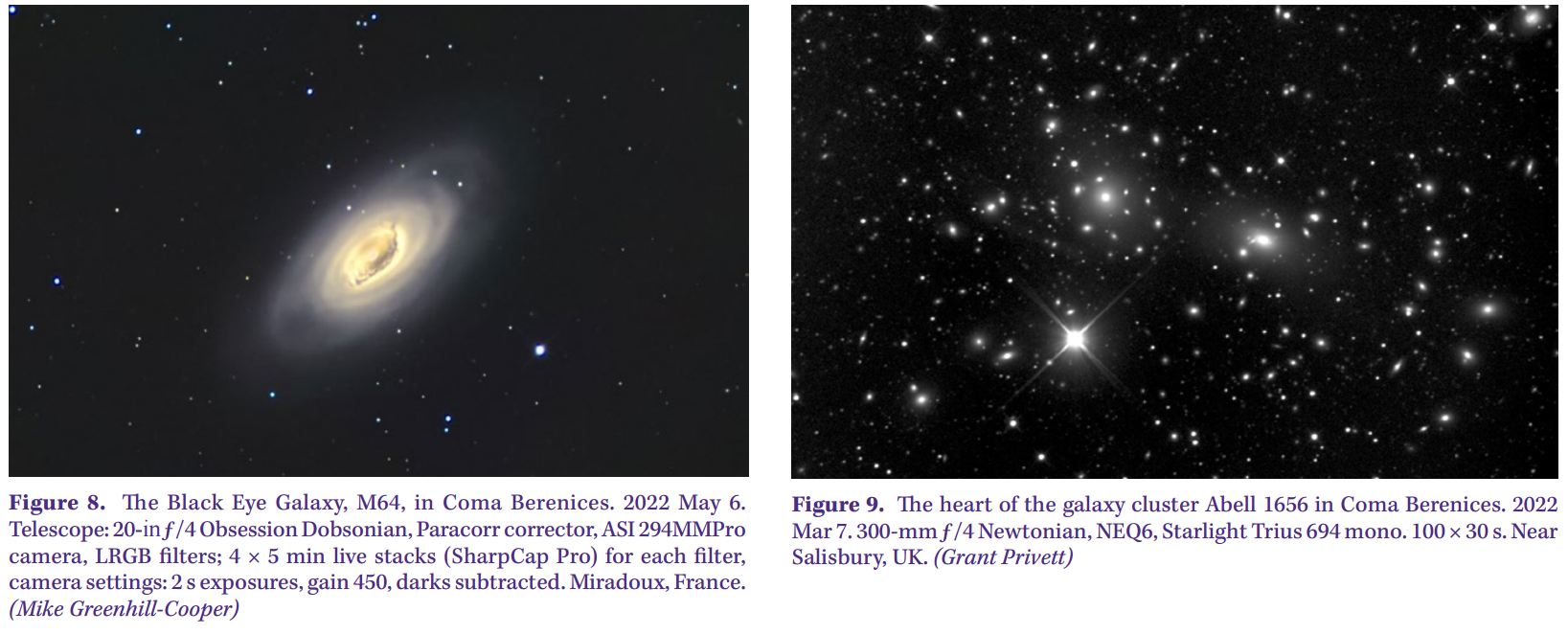
As we journey further south, we can enjoy a Black Eye. M64 (Figure 8) is so named for the very prominent, thick, dark dust lane facing us – a complex mass of dust and gas in this 8th-magnitude galaxy, located 17.5 million light-years away. It appears as an oval, measuring 10.5 × 5.5 arcmin and inclined by 60 degrees.
More testing challenges await the experienced deep-sky observer. Try the Coma Galaxy Cluster, centred on the supergiant elliptical galaxies NGC 4889 and NGC 4874. This is Abell 1656 (Figure 9), one of the two clusters (along with the Leo Cluster, Abell 1367) that make up the Coma Supercluster. It is rich, with over 1,000 identified members at 320 million light-years. The majority are ellipticals, with a few lenticulars and spirals on the outskirts, avoiding being cannibalised by the central monsters.
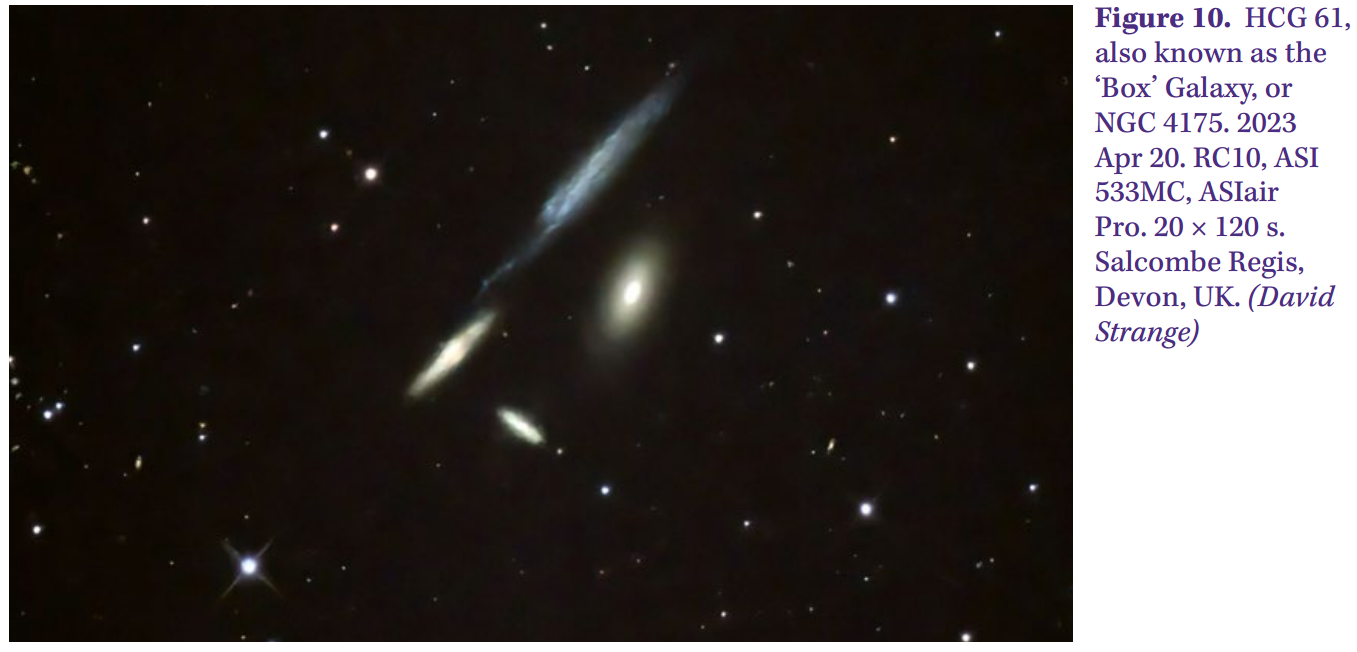
Coma Berenices also hosts one of the best Hickson Compact Galaxy Groups (HCGGs). While many of the HCGGs are hard to observe visually from our light-polluted skies, some provide good imaging challenges. Perhaps the easiest in the spring sky is Hickson 61 (the ‘Box’; Figure 10). Unusually for a Hickson group, all four members have NGC designations (NGCs 4169, 4173, 4174 and 4175). Their rectangular arrangement gives the group its nickname, while their variety in appearance adds much of the interest. The galaxies range from magnitude 13.2 to 14.4.
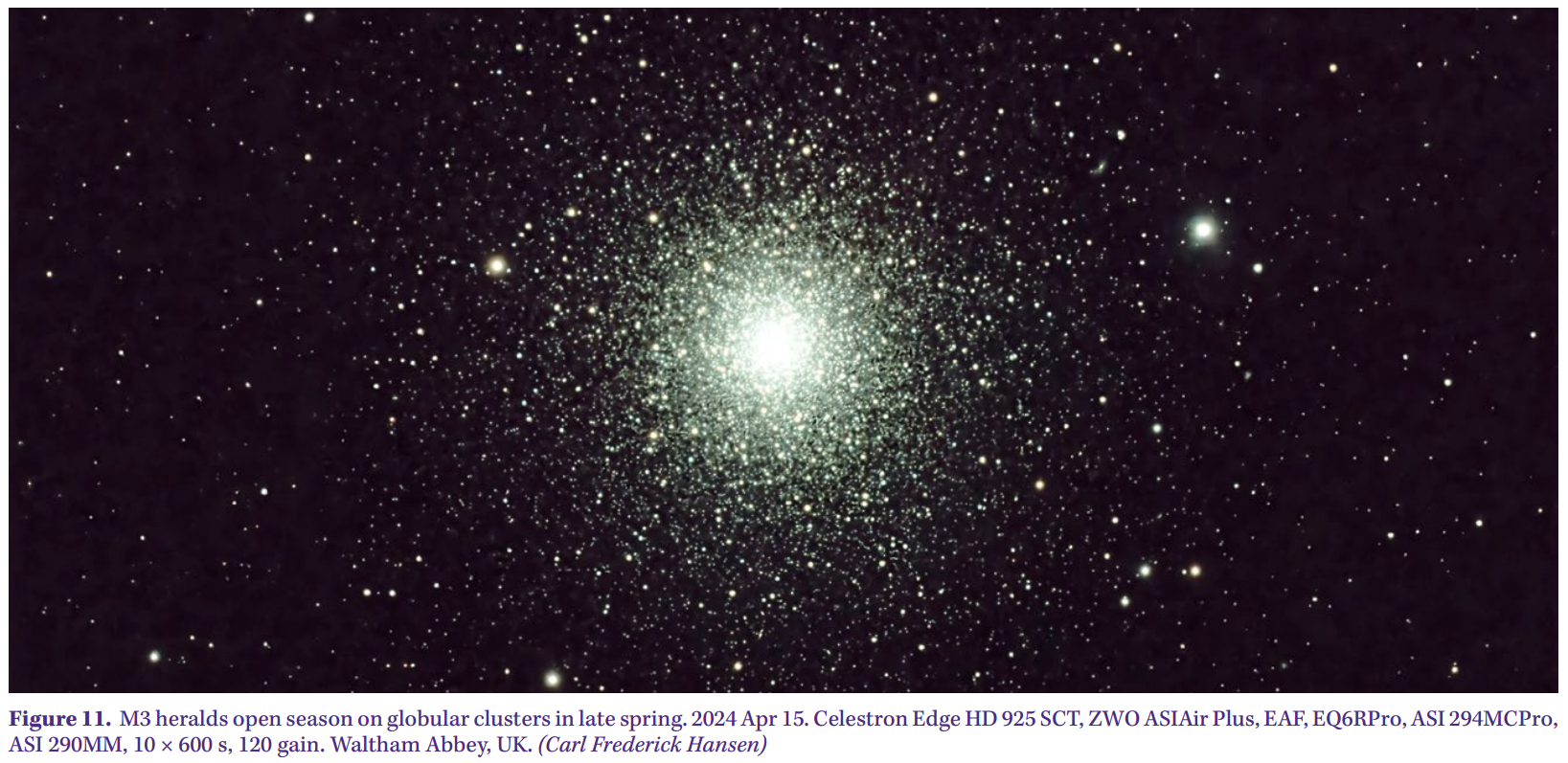
As May arrives with its shorter, brighter nights, galaxies become trickier to observe, but fortunately, higher-surface-brightness targets become prominent. The best on display are globular clusters – huge, spherical collections of old stars that formed at the dawn of our galaxy’s creation over 13 billion years ago. Prominent examples for late evening viewing include M3 (in Canes Venatici; Figure 11), M5 (in Serpens Caput), and M53 with nearby NGC 5053 (both in Coma Berenices).
The solar system
Sun & Moon
The crescent Moon traverses the Pleiades mid-late evening on Apr 1, although the whole event will be increasingly compromised as the Moon sets at 23:40 UT. A good, flat western horizon will be needed to see the finale.
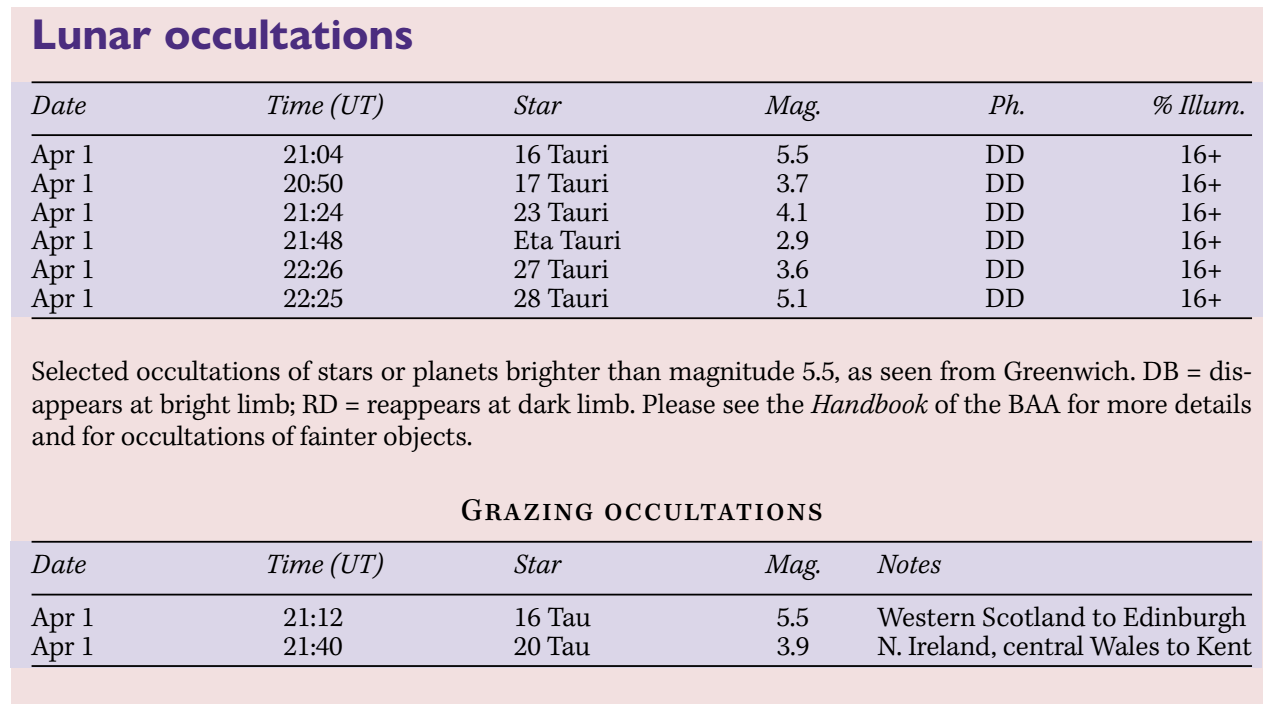
There are several occultations as the Moon ploughs through the Pleiades, although low in the west. All brighter events are listed in the 2025 Handbook of the BAA. The table shows the start of the predicted occultation of stars brighter than magnitude 5.5 as seen from There are no bright stars occulted during May.
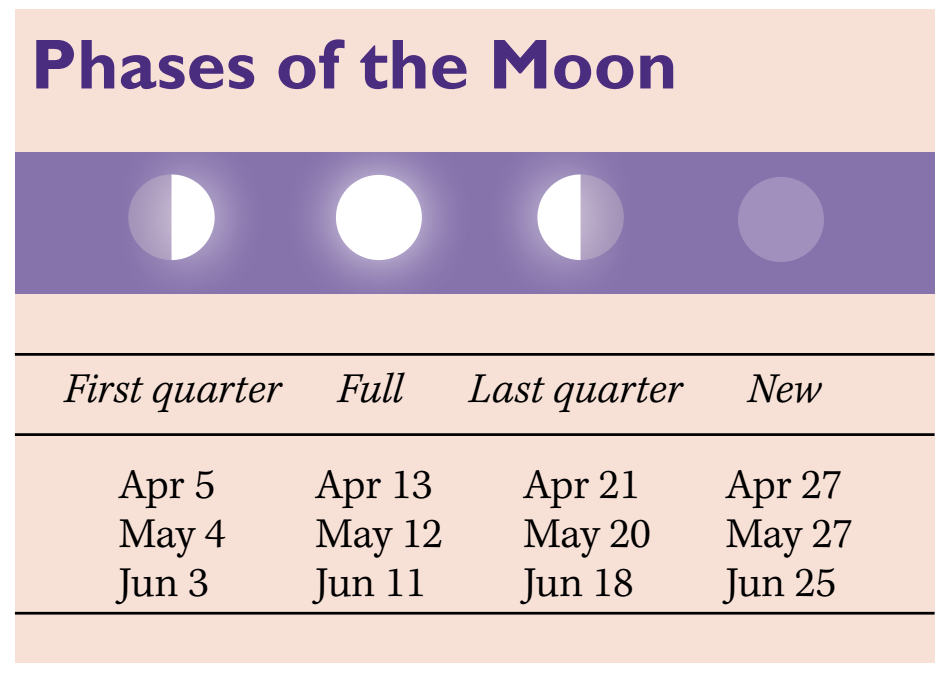
The Sun is at solar maximum this year and sunspot activity could be spectacular with aurorae a possibility even from southern Britain. Remember the spectacular display of 2024 May 10!
There are no lunar or solar eclipses in either April or May.
Planets
The procession of the planets, so hyped in January this year, is now well over with only Jupiter, Uranus and Mars being left in the evening sky, and way past their best.
Mercury is a morning planet in April, reaching western elongation on Apr 21 but too low to view from the UK. Thereafter it swings behind the Sun to reach superior conjunction on May 30.
Venus appears as a very thin crescent in the predawn sky in early April, following its inferior conjunction in March. Although low in the east, it becomes a beacon as it climbs higher, reaching western elongation on May 31.
Mars is much diminished in brightness and size, with a magnitude of +0.5 and just 8 arcsec in early April. Well placed in Gemini initially, it moves through Cancer in May, eventually lying west of Regulus (alpha Leonis) by the month’s end, when it is slightly fainter than Leo’s brightest star. By May 31, its diameter will be a small 5.6 arcsec.
Jupiter begins April well placed, but thereafter it rapidly dips into the western gloaming at twilight, still nestled between the horns of Taurus, the Bull.
Saturn emerges into the morning sky but is low throughout this period.
Uranus is at conjunction on May 18, so inaccessible.
Neptune is also difficult, although close to Saturn in a bright sky at the end of May.
Minor & dwarf planets
(2) Pallas, at 10th magnitude, is located in Delphinus and rises after midnight at the end of May. (3) Juno, also at 10th magnitude, is in Serpens Caput. (4) Vesta, in Virgo at magnitude 5.7, will be the easiest to spot.
Meteors
The April Lyrids mark the beginning of the spring meteor showers, with a maximum on Apr 22. The last-quarter Moon interferes to an extent, and the shower is rarely rich, although there have been notable years (1922 and 1982). The radiant, now in Hercules, is high in the midnight sky. Although the Lyrids have a typical Zenithal Hourly Rate of 15, the shower can occasionally surge to a ZHR of 100. Dust from long-period comet C/1861 G1 Thatcher is responsible and it is thought to be the longest-known meteor shower, with records dating back to 687 BCE.
The eta Aquarids represent the best shower of this period, with the maximum occurring between May 5–7. Caused by debris from comet 1P/Halley, they are the spring equivalent of the autumnal Orionids. They are best observed an hour before morning twilight, when the Moon is absent.
Comets
There are no bright comets due in spring 2025.
1 Ridpath I., ‘Who named La Superba?’, J. Br. Astron. Assoc., 135(1), 73 (2025)
| The British Astronomical Association supports amateur astronomers around the UK and the rest of the world. Find out more about the BAA or join us. |
